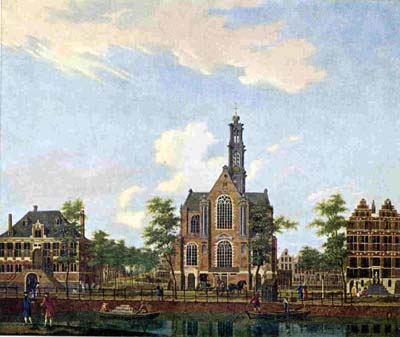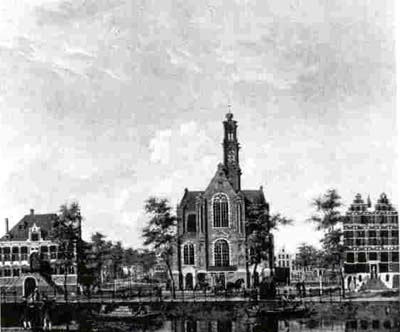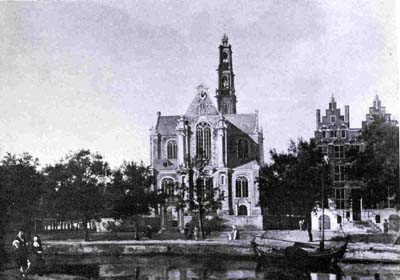
Bulletin 3 (II:1), 1964
Home
Français
Introduction
History
Annual Index
Author &
Subject
Credits
Contact



Notes on
an Eighteenth-Century Dutch Painting
by William A. Blom, Research Curator
Résumé en français
Pages 1 | 2
| 3
In 1957 the National Gallery of Canada acquired the painting A
View in Amsterdam by Isaak Ouwater (Fig. 1). This is the only
eighteenth century Dutch painting in the permanent collection.
Eighteenth-century Dutch artists are not as celebrated as their
predecessors of the seventeenth century, certainly not beyond the
borders of Rolland. It is for this reason that the Ouwater painting
in Ottawa is of particular interest.
During the seventeenth century Rolland reached a climax of artistic
expression, the quality of which was impossible to sustain or to
equal again. The eighteenth century could at best only carry forward
a tradition of technical competence, as the spirit of the country
had changed and lacked the vigour of the previous century. In
Rolland it was one of gestation, preparing the way for the
nineteenth.
The first half of the eighteenth century was still a continuation of
the seventeenth: Rolland remained a colonial power and continued to
prosper economically. During the second half of the century the
incompetence of the government (in particular that of the two stadtholders,
Willem IV and Willem V) contributed to the decline of the
country's fortunes. The activities of the Patriots ( 1775-87) almost
led to civil war, and French revolutionary armies easily overran the
country. French influence had, in fact, penetrated Rolland at a much
earlier date. During the 1660's French fashions held sway not only
in dress and manners but in architecture and interior decoration. It
was Daniel Marot who introduced the style of Le Nôtre in Rolland.
Despite the political setbacks of the eighteenth century,
architecture at tests for the country's prosperity at that time.
Many new merchants' houses were built in Amsterdam and in smaller
provincial towns. Not withstanding this outward prosperity, native
creative powers seemed drained, and the country grew inward and
somnolent. The Dutch were living on their capital, and a distasteful
complacency appeared in Dutch society for the first time. It is this
complacent and slightly tired face of Rolland that is reflected in
the work of her eighteenth-century painters.
The decline of Dutch painting had already begun towards the end of
the seventeenth century when the Rembrandt-Hals era was over and
French Baroque painting was being imitated. The eighteenth-century
painters' repertoire consisted of history painting, conversation
pieces, flower-painting, painted wall-paper, and topographical
views. The history painting was highly appreciated in its own time,
but today we find it dull. The conversation piece (gezelschapstuk)
had remained popular since the sixteenth century. (1) Despite
claims by its much-documented English counterpart, this particular
genre was of Dutch origin. Flower-painters continued the conventions
of the previous century, though somewhat lighter and looser in
style. Jan van Huysum (1682-1749) was one of the more renowned
flower-painters of that time and represents the link with earlier
traditions. Painted wall-paper was something new and the
topographical view was very popular and in great demand. There were
many competent painters and draughtsmen who travelled all over the
Law Countries and left an accurate and lively record of the towns
and villages as they appeared during the eighteenth century. Large
and richly illustrated topographical books were published at that
time, with the majority of illustrations by artists such as Jan ten
Coillpe (1713-1761) who was perhaps the best of them, Cornelis Pronk
(1691- 1759), Jan de Beyer (1703-1785), Paul van Liender
(1731-1797), Jan Ekels (1724-1781), his son of the same name, and
others. Their drawings in particular are of great interest.
Dutch topographical painting of the latter half of the eighteenth
century is characterized by its scrupulous attention to detail and
precise observation of nature and does not strictly imitate earlier
painting. A striking feature of these eighteenth-century views is a
predominant lack of activity: the light falls clearly on open
squares and canals, a few people are about who seem to stand still
and have nothing to do. The effect is rather that of the intimate
Dutch interior, but here the well-ordered lives of the citizens move
out into the street. In front of the pleasant Dutch houses
there seems to hover an endless, almost unreal, quiet.
These characteristics are perfectly exemplified in the work of Isaak
Ouwater. He was born 16 March 1750 in Amsterdam and died there on 4
March 1793. During his comparatively short life he was active in
Utrecht, Haarlem, and Amsterdam, and chiefly painted views of these
towns with figures. (2) Little else besides these few facts is known
about him. (3) The painting in the national Gallery, A View in
Amsterdam (Fig. 1) , signed and dated 1778, (4) depicts the West
Church (Westerkerk) which is the largest and perhaps the most
monumental of the Renaissance churches in that city. (5) The church
was built around 1620 from plans by Hendrick de Keyser, who died in
1621, and the steeple was completed in 1638 based on an altered
design. In this painting the West Church is seen across the
Keizersgracht and the houses beyond the church are on the
Prinsengracht. The house to the right of the church was a merchant's
house constructed in 1618. (6) The impressive building on the left
was a guard-house built in 1619 and was called the West-Hall. (7)
This view in Ouwater's painting is almost identical to that painted
by Jan van der Heyden (1637-1712) during the previous century, View
of the West Church at Amsterdam, in the Wallace collection (Fig.
2). The figures are by Adriaen van de Velde (1635/6-1672). (8) Van
der Heyden's painting is not dated but it is known that his
townscapes containing figures by van de Velde date from the decade
before van de Velde's death in 1672. (9) In van der Heyden's later
works the figures are by Eglon van der Neer (1635/6-1703). Van der
Heyden, called the Dutch Canaletto, is often regarded as the first
artist in Arnsterdam to paint townscapes, although Job Berckheyde
(1630-1693) and Gerrit Berckheyde (1638- 1698) were already active
in Haarlem, at that time a provincial town of moderate size which
showed a marked interest in art.
The great difference between the two Berckheydes and van der Heyden
is that towards the end of the seventeenth century the latter
adopted an entirely personal style in townscape painting. He appears
to have been a follower of Leyden artists such as Gerard Dou
(1613-1675) and Frans van Mieris (1635-1681), which probably
accounts for his depicting every building in minute detail, and
achieving exquisite finish. Van der Heyden's paintings of Amsterdam
are important as in these works are to be found exact renderings of
urban scenes, whereas his topography of other towns is sometimes
wayward, presumably based on sketch books. Despite this, his
painting has had a continuous influence on Dutch artists as late as
the nineteenth century.
Next Page | View
of the West Church at Amsterdam
1 | 2 | 3
Annual Index | Author & Subject | Credits | Contact
This digital collection
was produced under contract to Canada's Digital Collections program,
Industry Canada.
"Digital
Collections Program, Copyright
© National Gallery of
Canada 2001"